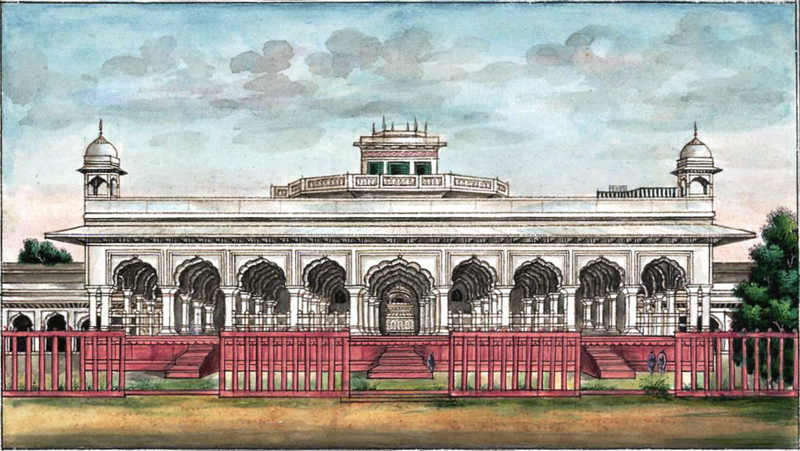File:Reminiscences of Imperial Delhi The Diwan-i ‘Am from the west.png

Original file (1,087 × 613 pixels, file size: 1.42 MB, MIME type: image/png)
Captions
Captions
Summary edit
| DescriptionReminiscences of Imperial Delhi The Diwan-i ‘Am from the west.png |
English: One of the principal objects after entering the Palace, that attracts attention, is the Dewan e Aum, or Public Hall of Audience for all descriptions of persons. It is situated at the upper end of a spacious square and though at present much neglected is still a noble building. The length is 196 feet and breadth 64 feet. The roof is supported by a succession of flat arches of red stone on pillars of the same material, but now disfigured by the bad taste of modern times with a coating of white plaster. On each side of the Hall and all round the square are arcades which are said in former days of splendor to have been adorned with the richest tapestry. But in these degenerate times, the walls are bare, and the buildings themselves used as stables or lumber rooms.
In the interior of the Dewn e Aum is a massive marble throne handsomely carved and below it a large slab of the same material on which on public days, the chief ministers took their stand and handed up petitions to the Emperor. This slab was beautifully inlaid with mosaic work, all of which has been removed. In a recess in the rear of the throne is a gilt doorway through which the Emperor entered. The recess is ornamented with mosaic work of the most exquisite workmanship, and of which several specimens will be found in the succeeding pages. The Dewan e Aum is now never appropriated to its original purposes and indeed is nothing more than a receptacle for all kinds of rubbish. Shame to the Ruling Power, whether it be the King as immediate or the British Government as Lord Paramount. [The Diwan-i ‘Am from the west. The Diwan-i 'Am is a large pavilion, at the centre of the Red Fort, for public imperial audiences. It is positioned between the public and private parts of the fortress. It faces a large open courtyard, and behind the back wall lie the private imperial palaces.] Inscribed: naqsha-i divan-i ‘amm andarun-i qil‘a-i shahjahanabad. ‘amal-i Mazhar ‘Ali Khan. [Closer view of the imperial jharoka in the Diwan-i ‘Am. The ornate, canopied, throne-balcony for the emperor, stands at the centre of the back wall. It is entirely made of white marble, carved and inlayed with precious stones in pietra dura. Panels of pietra dura work depicting birds and flowers decorate the wall behind the throne, some of these were imported from Italy.] Inscribed: naqsha-i kursi andarun-i divan-i ‘amm ast. ‘amal-i Mazhar ‘Ali Khan. From 'Reminiscences of Imperial Delhi’, an album consisting of 89 folios containing approximately 130 paintings of views of the Mughal and pre-Mughal monuments of Delhi, as well as other contemporary material, with an accompanying manuscript text written by Sir Thomas Theophilus Metcalfe (1795-1853), the Governor-General’s Agent at the imperial court. Acquired with the assistance of the Heritage Lottery Fund and of the National Art-Collections Fund. |
||||||||||||||||||||
| Date | |||||||||||||||||||||
| Source | http://www.bl.uk/onlinegallery/onlineex/apac/addorimss/t/019addor0005475u00036vrb.html | ||||||||||||||||||||
| Author |
creator QS:P170,Q127010 |
||||||||||||||||||||
Licensing edit
| Public domainPublic domainfalsefalse |
|
This work is in the public domain in its country of origin and other countries and areas where the copyright term is the author's life plus 100 years or fewer. | |
| This file has been identified as being free of known restrictions under copyright law, including all related and neighboring rights. | |
https://creativecommons.org/publicdomain/mark/1.0/PDMCreative Commons Public Domain Mark 1.0falsefalse
File history
Click on a date/time to view the file as it appeared at that time.
| Date/Time | Thumbnail | Dimensions | User | Comment | |
|---|---|---|---|---|---|
| current | 15:25, 2 January 2014 |  | 1,087 × 613 (1.42 MB) | Gryffindor (talk | contribs) | == {{int:filedesc}} == {{Information |Description={{en|One of the principal objects after entering the Palace, that attracts attention, is the Dewan e Aum, or Public Hall of Audience for all descriptions of persons. It is situated at the upper end of a... |
You cannot overwrite this file.
File usage on Commons
The following page uses this file:
- File:Diwan-i-Am Red Fort 1843.jpg (file redirect)
Metadata
This file contains additional information such as Exif metadata which may have been added by the digital camera, scanner, or software program used to create or digitize it. If the file has been modified from its original state, some details such as the timestamp may not fully reflect those of the original file. The timestamp is only as accurate as the clock in the camera, and it may be completely wrong.
| Horizontal resolution | 47.23 dpc |
|---|---|
| Vertical resolution | 47.23 dpc |
